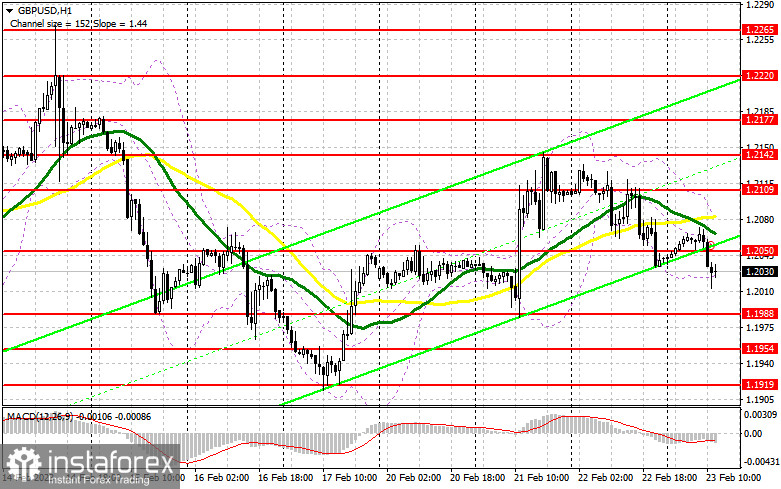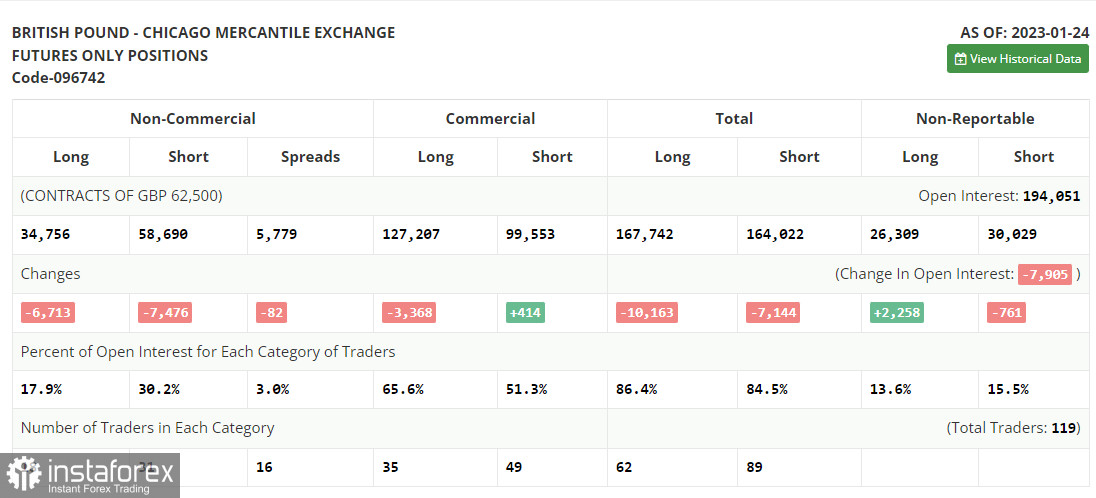I focused on the level of 1.2037 when I made my morning forecast and suggested trading actions based on it. Let's analyze the 5-minute chart to see what happened. The decline and breakout of this range occurred quite quickly. Then a reversal test occurred, producing a sell signal. But, as of this writing, no downward movement has taken place, raising questions about the accuracy of the entry point. The technical image was altered in the afternoon.

You require the following to open long positions on the GBP/USD:
The focus is on US GDP and labor market data, which are anticipated to match analysts' predictions and allow the pound to recover from morning losses. It is best to avoid rushing into long positions while trade is below 1.2037 because this indicates that the pressure on the pair will continue. Only after updating the closest support in the area of 1.1988 will I decide whether to buy. If there is a false collapse there in the afternoon, you will be able to buy with the possibility of a return to 1.2050 at that time. Only after fixing and testing this range from top to bottom after the US data will I bet on the GBP/USD continuing to go up to the maximum of 1.2109. A break above this level will also bring the potential for growth to 1.2142, where I've fixed profits. The bulls will lose control of the market and put more pressure on GBP/USD if they are unable to complete the tasks assigned to them and miss 1.1988 in the afternoon, which is also likely given the speeches anticipated by Federal Reserve System members. In this situation, I suggest against making hasty purchases and only starting long positions around the next support level of 1.1954, and then only in the event of a false breakout. I'll buy GBP/USD right away only if it rises over the monthly low of 1.1919 with the intention of a correction of 30-35 points during the day.
For opening short positions on the GBP/USD, you will need:
Sellers completed the tasks set during the first half of the day, causing the pound to collapse. The new resistance level of 1.2050, which was created by the conclusion of the European session, must now be defended. It will be simple to deal with this due to the United States' strong fundamental statistics. The emergence of a false breakout at 1.2050 will be the best-case scenario for selling. In this situation, the target will be to support 1.1988. With its breakthrough and reversal test, buyers' hopes for an additional upward correction will be disappointed. This will make bears more powerful in the market and generate a sell signal with a decline below 1.1954. The 1.1919 area will be the farthest target, and any changes there will signal the start of another bear market. I'll set the profit there. At the end of the week, bulls may actively enter the market given the possibility of a GBP/USD rise and the absence of sellers at 1.2050 in the afternoon. By turning your attention to 1.2109, I suggest you not make hasty sales. Only a false breakout creates an opening for short positions there. If there is no movement at this price, I will sell GBP/USD right away at the highest price of 1.2142, but only if I believe the pair will fall back by 30-35 points during the trading day.

Due to a CFTC technical issue that has persisted for more than two weeks. The most recent COT reports have not yet been released. The data after that is only for January 24.
Both long and short positions were dramatically reduced in the COT report (Commitment of Traders) for January 24. But, given the difficulties the UK government is now facing, including dealing with strikes and demands for wage increases while also attempting to achieve a continuous fall in inflation, the recent reduction was within the acceptable value. Yet, for the time being, everything is receding into the background as we await the meetings of the Federal Reserve System, with its anticipated less aggressive policy, and the Bank of England, which is certain to maintain an aggressive tone of remarks by raising the rate by another 0.5%. All of this will benefit the British pound, therefore I'll wager on it strengthening even more, unless, of course, something extraordinary occurs. According to the most recent COT data, long non-commercial positions declined by 6,713 to 34,756 while short non-commercial positions decreased by 7,476 to 58,690, resulting in a fall in the non-commercial net position's negative value to -23,934 from -24,697 a week earlier. We will continue to keep a careful eye on the economic indicators for the UK and the decision made by the Bank of England because such insignificant changes do not significantly alter the balance of power. In contrast to 1.2290, the weekly ending price increased to 1.2350.

Signals from indicators
Moving Averages
Trade is taking place below the 30 and 50-day moving averages, which suggests that the pair will continue to fall.
Notably, the author considers the time and prices of moving averages on the hourly chart H1 and departs from the standard definition of the traditional daily moving averages on the daily chart D1.
Bands by Bollinger
The indicator's upper limit, which is located at 1.2080, will serve as resistance in the event of expansion.
Description of indicators
- Moving average (moving average determines the current trend by smoothing out volatility and noise). Period 50. The graph is marked in yellow.
- Moving average (moving average determines the current trend by smoothing out volatility and noise). Period 30. The graph is marked in green.
- MACD indicator (Moving Average Convergence / Divergence - moving average convergence/divergence) Fast EMA period 12. Slow EMA period 26. SMA period 9
- Bollinger Bands (Bollinger Bands). Period 20
- Non-profit speculative traders, such as individual traders, hedge funds, and large institutions use the futures market for speculative purposes and to meet certain requirements.
- Long non-commercial positions represent the total long open position of non-commercial traders.
- Short non-commercial positions represent the total short open position of non-commercial traders.
- Total non-commercial net position is the difference between the short and long positions of non-commercial traders.





















